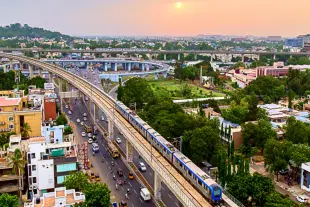Infrastructure
Chennai Metro's Strategic Downsizing: Phase 2 Sees Reduced Station Sizes Amid Lack Of Funding From Centre
V Bhagya Subhashini
Aug 09, 2024, 04:31 PM | Updated 06:06 PM IST
Save & read from anywhere!
Bookmark stories for easy access on any device or the Swarajya app.


The Chennai Metro Rail Limited (CMRL) has announced a significant cost-cutting measure in its Phase 2 expansion, with underground stations being scaled down by nearly 40 per cent.
This decision comes in the wake of a lack of financial support from the Union government, despite repeated requests from the Tamil Nadu government.
The Rs 63,246 crore project, spanning 118.9 kilometres (km), is currently being implemented as a state sector project, with the entire financial burden falling on the Tamil Nadu government.
In response to Dravida Munnetra Kazhagam (DMK) Member of Parliament Dayanidhi Maran's inquiry regarding the delay in fund allocation and project approval, the Union Minister of State for Housing and Urban Affairs, Tokhan Sahu, clarified that such high-cost projects are approved based on their feasibility and the availability of resources.
“Currently, the expenditure towards the implementation of Chennai Metro Phase 2 is borne by the Government of Tamil Nadu,” he said, confirming that there has been no fund allocation from the Centre for this phase.
Previously, the Tamil Nadu government approached the central government for funding support for the Chennai Metro Phase 2 project under a 50:50 equity share model. Additionally, the state has requested loan assistance from bilateral or multilateral agencies to bolster the project’s financial foundation.
With 128 stations, the second phase consists of three corridors: Corridor 3 from Madhavaram to SIPCOT (45.8 km), Corridor 4 from Lighthouse to Poonamalle Bypass (26.1 km), and Corridor 5 from Madhavaram to Sholinganallur (47 km).
Design And Cost-Cutting Measures
The most notable change in Phase 2 involves the reduction in the size of underground stations, a move aimed at managing costs while ensuring safety and functionality.
The length of these stations has been reduced from 240 metres in Phase 1 to 150 metres in Phase 2, resulting in savings of over Rs 2,000 crore in systems procurement and several thousand crores in construction costs.
One of the key areas where savings have been realised is the tunnel ventilation system. In Phase 1, each station was equipped with eight exhaust fans, but this has been reduced to just two fans in Phase 2. These fans, positioned at either end of the station on the concourse level, are connected to ducts below the platforms.
This design allows for efficient smoke extraction and fresh air circulation in emergencies while minimising the space required for the ventilation system. As a result, the area needed for these systems has been reduced from 2,485 square metres in Phase 1 to just 750 square metres in Phase 2.
Expert Design And Compliance
The new tunnel ventilation system was developed through collaboration between CMRL officials and international experts, including Aecom Hong Kong, Systra in France, and Milan Metro in Italy.
The design complies with guidelines from the National Fire Protection Association and the National Building Code and has been validated by both general consultants and external experts.
As per a Times of India report, the cost per kilometre of the underground line in Phase 2 has been reduced to Rs 500 crore, bringing the total project cost down from an initial estimate of Rs 89,000 crore to Rs 63,432 crore.
Shift Towards Smaller Stations
This trend towards smaller underground stations is not unique to Chennai but reflects a broader shift across India's metro systems. With urban areas becoming increasingly congested, the need to optimise space and reduce costs has led to the reevaluation of station sizes and equipment. In fact, the length of underground stations was already reduced to 150 metres during the Phase 1 extension in 2016-17.
R Ramanathan, a former director of CMRL, noted that these reductions are part of ongoing efforts to deliver a cost-effective metro system without compromising safety or functionality.
As Chennai Metro moves forwards with its Phase 2 expansion, these strategic design choices will be critical in managing the project’s budget while ensuring the city’s transit infrastructure remains modern and efficient.
V Bhagya Subhashini is a staff writer at Swarajya. She tracks infrastructure developments.





